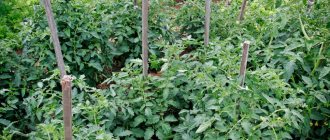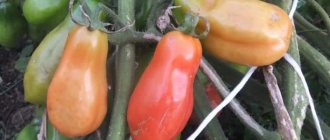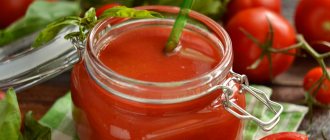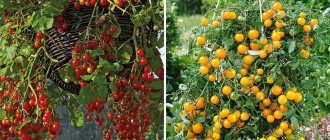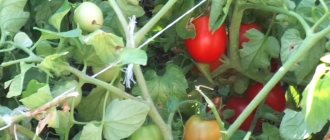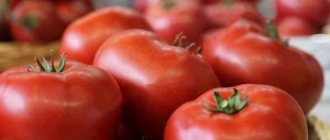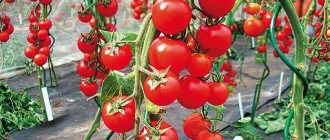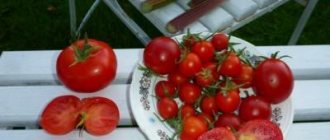Vegetable growing » Tomatoes
0
1222
Article rating
Kira Stoletova
A correctly selected variety is the key to an excellent harvest. Among the large number of varietal varieties of tomatoes, there is an F1 hybrid, which has been grown by domestic gardeners for more than 10 years - the Ritchie F1 tomato.
Characteristics of the Richie tomato variety
Ritchie tomatoes: variety description
| Variety name | Richie |
| general description | Early ripening, determinate variety of tomatoes |
| Originator | Holland |
| Ripening period | 80-95 days |
| Form | Rounded |
| Color | Red |
| Average weight of tomatoes | 90-120 grams |
| Application | Universal, good for whole fruit canning |
| Productivity of the variety | 1-1.5 kg per bush |
| Features of cultivation | Requires shaping and tying |
| Disease resistance | Resistant to major tomato diseases |
Tomato "Richie" f1, description of the variety: this is a very early ripening tomato, 80-95 days pass from planting seedlings to the first fruits. The plant is short, 50-70 cm . The type of bush is standard, determinate. Read about indeterminate varieties in this article. “Richie” is recommended for growing in greenhouses, hotbeds and under film, but it also grows successfully in open ground; some try to grow it on the balconies of city apartments. This tomato has a very high degree of protection against fungal diseases. Has F1 hybrids of the same name .
Ripe fruits are red and round in shape. Small tomatoes from 90 to 120 g . The number of chambers is 2-3, the dry matter content is approximately 5%. The collected fruits can be stored for a very long time and tolerate long-distance transportation well. For these qualities, they are loved not only by summer residents, but also by farmers.
You can compare the weight of tomatoes of this variety with others in the table below:
| Variety name | Fruit weight (grams) |
| Richie | 90-120 |
| Russian size | 650-2000 |
| Andromeda | 70-300 |
| Grandma's gift | 180-220 |
| Gulliver | 200-800 |
| American ribbed | 300-600 |
| Nastenka | 150-200 |
| Yusupovsky | 500-600 |
| Dubrava | 60-105 |
| Grapefruit | 600-1000 |
| Golden Jubilee | 150-200 |
Bush care
"Richie F1" is a low-growing determinate plant. There is no need to garter or support the bush, and shaping is carried out only in the greenhouse. Therefore, the agricultural technology for growing it comes down to basic measures:
- Watering. The volume of watering is selected individually for a specific climate zone. The soil should be moistened to a depth of 25-30 cm, and water should not stand on the bed;
- Loosening. In cool weather, the bed is loosened at least once every 5 days, during drought - no more than once a week. It is advisable to carry out loosening between waterings to prevent the formation of an earthen crust;
- Formation. In a greenhouse, bushes are formed into 3-4 stems, on a balcony - 1-2 stems. Stepchildren are cut off when they grow 4-5 cm, leaving “stumps” of 2 cm;
- Feeding. Root fertilization is carried out every 2 weeks, alternating organic matter and mineral complexes (mullein and superphosphate).
IMPORTANT: When feeding, you need to monitor the condition of the plants. If growth dynamics are weak, the amount of fertilizer is increased, if there are no ovaries, it is reduced
Characteristics
Hybrid tomatoes "Richie" are very well suited for whole-fruit canning. It will perfectly complement any dish with its taste. They also make very tasty and healthy juice; lecho and purees are also very good.
Under good greenhouse conditions, this species yields 1-1.5 kg per bush, with a planting density of 7-8 plants per square meter, this yields up to 10 kg; in open ground the yield is slightly lower. This is a very modest figure.
You can compare the yield of Ritchie with other varieties in the table below:
| Variety name | Productivity |
| Richie | 1-1.5 kg per bush |
| De Barao the giant | 20-22 kg per bush |
| Polbig | 4 kg per square meter |
| Sweet bunch | 2.5-3.2 kg per square meter |
| Red bunch | 10 kg per bush |
| Summer resident | 4 kg per bush |
| Fat Jack | 5-6 kg per bush |
| Pink Lady | 25 kg per square meter |
| Countryman | 18 kg per bush |
| Dad | 6 kg per bush |
| Golden Jubilee | 15-20 kg per square meter |
Planting seedlings in a permanent place
The seedlings are planted in previously prepared, loosened soil, enriched with organic fertilizers - humus, manure or ash. The most optimal predecessors for tomatoes in the garden are onions, carrots or cabbage.
Sprouts 55–60 days old are suitable for planting. It is not recommended to plant plants too densely; the optimal scheme is 40×70, where per 1 sq. m of soil there are no more than 4 bushes. To achieve maximum plant productivity, experts recommend pinching every 7–10 days, removing shoots (stepchildren) less than 4 cm long from the stem. The bush must be formed into 1 stem so that the fruits receive maximum nutrients.
You should also remove the lower leaves, which, firstly, interfere with the full development of tomatoes and “select” valuable components necessary for fruit ripening, and secondly, they collect disease spores, for example, late blight, on soil damp from watering.
Important! If you keep the seedlings in containers and let them bloom, then they will stop their vegetative development, remain in the “undergrowth” phase and will not be able to produce a high-quality harvest
Advantages and disadvantages
The advantages of the Richie tomato variety include its keeping quality and transportability, which are very high. As well as disease resistance and early ripening. Some lovers note that it can be grown on the balcony.
The main advantages of a “guest from Holland” include:
- early ripeness;
- the ability to grow at home;
- high immunity;
- good taste.
The disadvantages include not very high yields and capriciousness to external conditions, such as temperature, watering and fertilizing.
Features of cultivation
Although the bush is not tall, it is better to tie it up and strengthen the branches with supports. It should be formed into three or four stems, if grown on the balcony, then two. This variety is quite demanding regarding watering and lighting conditions.
It responds very well to complex feeding at all stages of growth.
Read all about fertilizers for tomatoes on our website:
- Organic, mineral, phosphorus, ready-made, TOP of the best.
- Yeast, iodine, ash, ammonia, hydrogen peroxide, boric acid.
- For seedlings, foliar, when picking.
You should also pay attention to the fact that tomato grows better in neutral soils; in acidic soils it may lose yield. On our website you will find a series of articles on this topic. Read about what types of soil for tomatoes exist, which soil is more suitable for seedlings and which for adult plants in greenhouses, how to make your own soil mixture, how to prepare soil in a greenhouse for spring planting.


